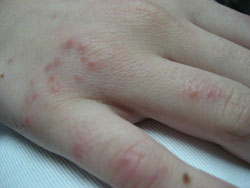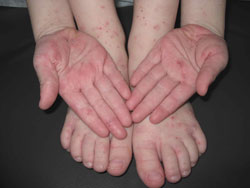The Toronto Dermatology Centre is one of the best places in Canada to manage your skin. Our staff of outstanding dermatologists can offer both a comprehensive assessment and diagnosis of your skin, and also discuss all the treatment and prevention options for getting rid of this pesky bug.
 Scabies is caused by a tiny bug that is often hard to detect, and causes a fiercely, itchy skin condition. The condition can strike anyone of any race or age, regardless of personal hygiene.
Scabies is caused by a tiny bug that is often hard to detect, and causes a fiercely, itchy skin condition. The condition can strike anyone of any race or age, regardless of personal hygiene.
How scabies Develops?
The microscopic mite bug that causes scabies can barely be seen by the human eye. Within several weeks of burrowing into the skin, the patient develops an allergic reaction causing severe itching; often intense enough to keep sufferers awake at night.
Human scabies is almost always caught from another person by close contact. It could be a child, a friend, or another family member. Everyone is susceptible. Scabies is not a condition only of low-income families and neglected children, although it is more often seen in crowded living conditions with poor hygiene.
Attracted to warmth and odor, the female mite burrows into the skin, lays eggs, and produces toxins that cause allergic reactions. Larvae, or newly hatched mites, travel to the skin surface, lying in shallow pockets where they will develop into adult mites. If the mite is scratched off the skin, it can live in bedding for up to 24 hours or more. It may take up to a month before a person will notice the itching.
What to Look For?
The earliest and most common scabies symptom is itching, especially at night. Little red bumps, tiny bites, or pimples appear. In more advanced cases, the skin may be crusty or scaly.
Scabies prefers warmer sites on the skin such as skin folds, where clothing is tight, between the fingers or under the nails, on the elbows or wrists, the buttocks or belt line, around the nipples, and on the penis. Mites also tend to hide in, or on, bracelets and watchbands, or the skin under rings. In children, the infestation may involve the entire body including the palms, soles, and scalp. Secondary bacterial infection may occur due to scratching.
Diagnosis
Your dermatologist will do a thorough examination in good lighting, with careful attention to skin crevices. Most cases of scabies can be diagnosed by your dermatologist without special tests. To confirm scabies your dermatologist may occasionally do a skin biopsy.
 Who is Most at Risk?
Who is Most at Risk?
Scabies is most common in those who have close physical contact with others, particularly children, mothers of young children, sexually active young adults, and elderly people in nursing homes.
The Elderly
Scabies among resident patients of nursing homes and extended care facilities has become a common problem due to delayed diagnosis since it can be mistaken for other skin conditions. The delay allows time for scabies to spread to nursing home staff and other residents.
Getting Rid of Scabies
- 5% permethrin cream (eg. Nix or Kwellada-P) is applied to the skin from the neck down over the entire body (including the palms of the hands, under finger nails, soles of the feet, and the groin) at bedtime and washed off the next morning. The same second scabies treatment should be repeated 1 week later. Side effects of the cream include mild temporary burning and stinging.
- Antihistamines or topical steroids may be prescribed to relieve itching, which can last for weeks, even after the mite is gone (“post-scabies itch”).
- 10% sulfur ointment may be used for infants or in pregnancy.
- If available, Ivermectin is an oral medicine that may be prescribed for the difficult to treat crusted form. It is not to be used in infants or pregnant women.
- Getting rid of the mites is critical in the treatment of scabies. Everyone in the family or group, whether itching or not, should be treated at the same time to stop the spread of scabies. This includes close friends, day care or school classmates, or nursing homes.
- Bedding on clothing must be washed or dry-cleaned.
- It is important to keep in mind that the itching may last for weeks even after successful treatment; it does not mean that you need to keep re-treating yourself.
Successful Eradication of Scabies Requires the Following:
See a dermatologist as soon as possible to begin scabies treatment. Remember, although you may be disturbed at the thought of bugs, scabies is no reflection on your personal cleanliness.
- Treat all exposed individuals whether obviously infested or not. Incubation time is 6-8 weeks so symptoms may not show up for a while. If you do not treat everyone, it is as if you were never treated.
- Apply treatment to all skin from neck to legs – this includes between toes, the crease between the buttocks, etc. If you wash your hands after application, you need to reapply the medication to your hands again.
- Wash clothes. Do all the laundry with the hottest water possible. The mite is attracted to scent. Any clean clothes hanging in the closet or folded in the drawers are OK.
- Items you do not wish to wash may be placed in the dryer on the hot cycle for 30 minutes, or pressed with a warm iron.
- Items may be dry-cleaned.
- Change the bedding.
- Carpets or upholstery should be vacuumed through the heavy traffic areas. Vacuum the entire house and discard the bag, just to be on the safe side.
- Pets do not need to be treated.
- Items that can’t be washed (e.g. teddy bear) may also be placed in a sealed plastic bag and placed in the garage for 2 weeks. If the mites do not get a meal within one week, they die.
